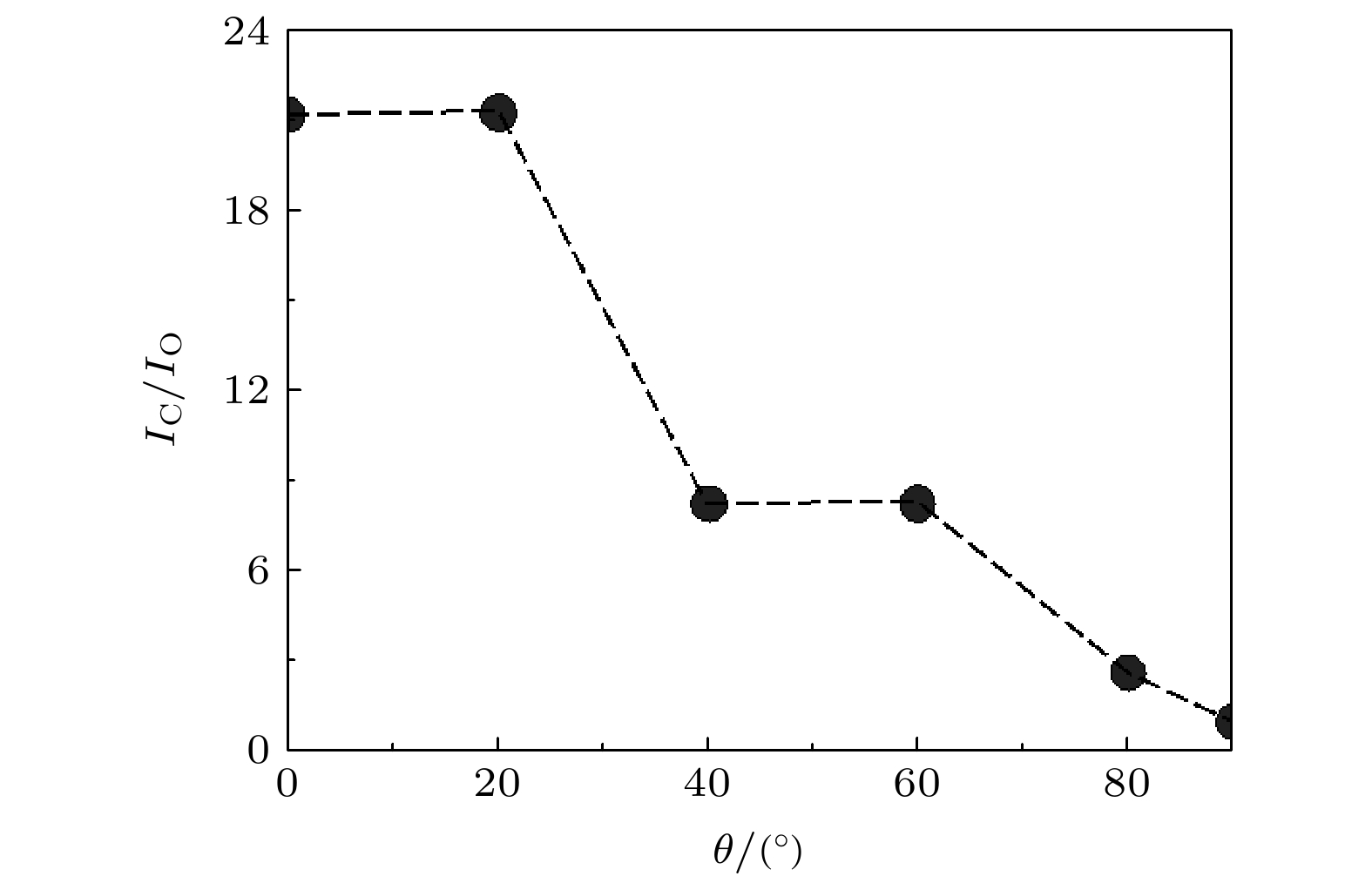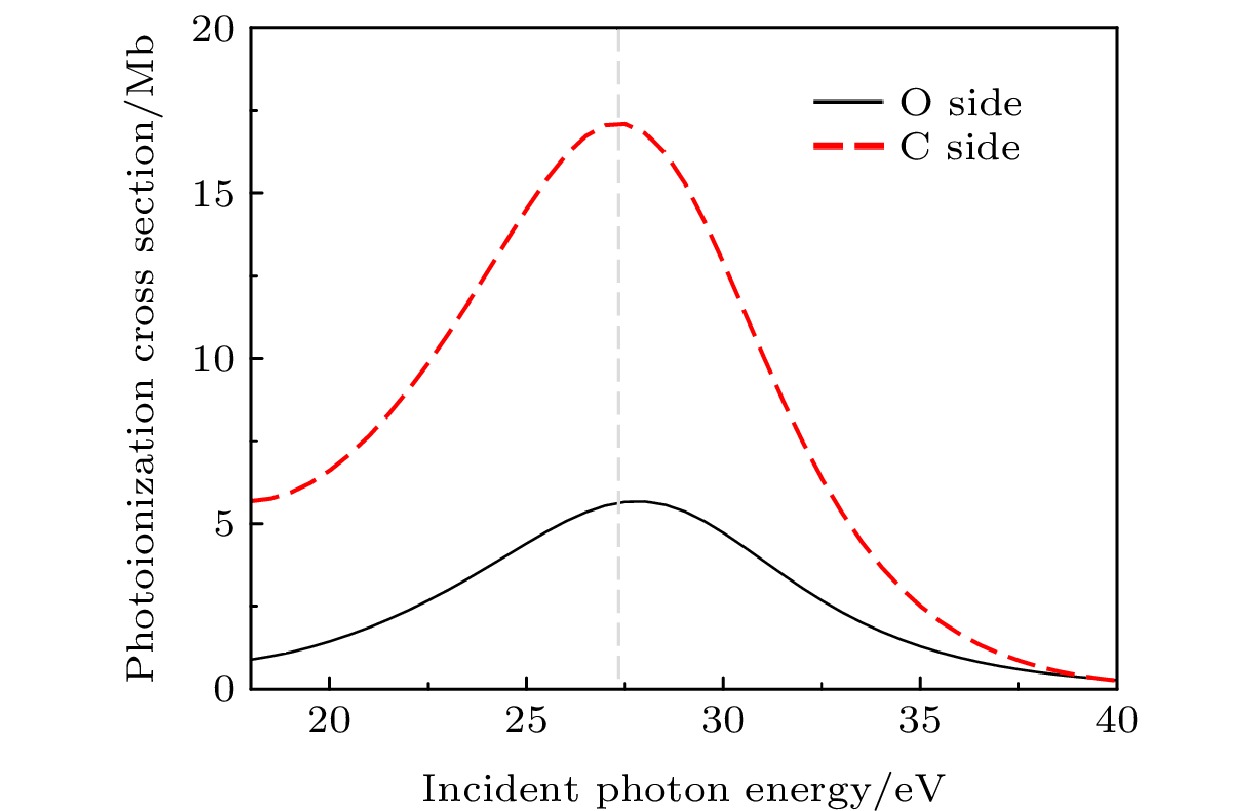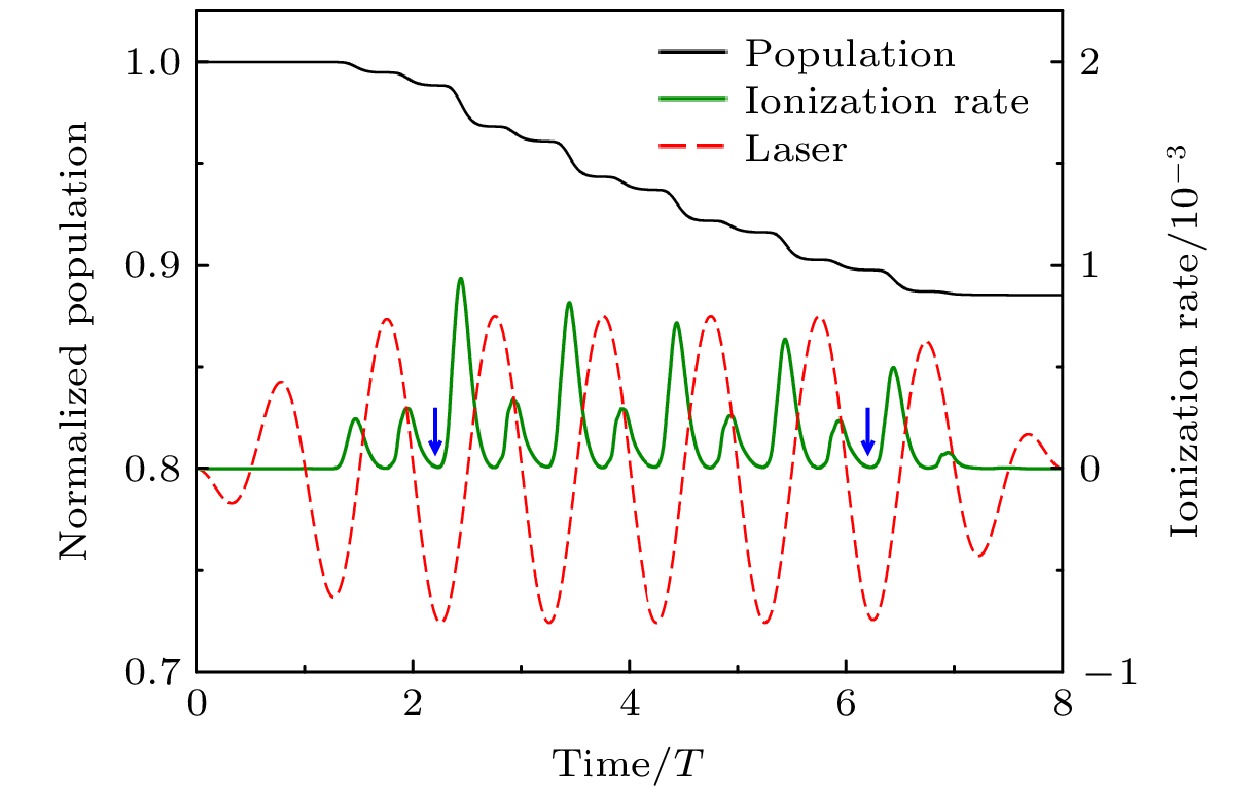-
Compared with nonpolar molecules, owing to the inherent asymmetry, polar molecules exhibit rich and very complex electronic dynamics under the interaction with strong laser fields. In this work, high-order harmonic generation (HHG) of polar molecules CO is investigated by using the three-dimensional time-dependent Hartree-Fock (3D-TDHF) theory, with all electrons active. Through the high harmonic spectra and time-frequency analyses, it is found that when the laser field polarizes along the molecular axis, the ionized electrons from the two sides (C side and O side) contribute differently to the harmonic radiation. On the one hand, the harmonic intensity from the C side is greater than that from the O side, which is caused by the ionization rate. On the other hand, for the lower-order (7th–17th order) harmonics of plateau region, only the electrons from the C side participate in the HHG. However, for its higher part (18th–36th order), the electrons from both C side and O side contribute to high harmonics simultaneously. Moreover, the difference between contributions from two sides is related to the alignment angle θ between the laser polarization and the molecular axis, and it reaches a maximum value around θ = 0º and a minimum value around θ = 90º. There are two strong resonances around harmonic order H12.6 (19.5 eV) and H18 (27.9 eV) in the harmonic spectra when θ = 0º. The first resonance around H12.6 reveals that part of electrons ionized from the C side recombine to the vicinity of the further O nucleus. Near the second resonance around H18, there appears a shape resonance. Nevertheless, the shape resonances from the C and O sides are disparate. Based on the strong-field approximation theory, the ratio between photoionization cross sections from C and O sides around the shape resonance is calculated. The ratio is about 5.5 from 3D-TDHF, which is greater than the result of 3 simulated by ePloyScat, where only HOMO is considered. This discrepancy reveals that multi-electron effects enhance the asymmetry of polar molecules. This work provides an in-depth insight into the asymmetry in HHG of polar molecules, which benefits the generation of isolated attosecond pulse . It also promotes the application of high harmonic spectra in tracking the ultrafast dynamics of electrons.
-
Keywords:
- high-order harmonic generation /
- polar molecule /
- time-dependent Hartree–Fock /
- shape resonance
[1] McPherson A, Gibson G, Jara H, Johann U, Luk T S, McIntyre I A, Boyer K, Rhodes C K 1987 J. Opt. Soc. Am. B: Opt. Phys. 4 595
 Google Scholar
Google Scholar
[2] Ferray M, L'Huillier A, Li X F, Lompre L A, Mainfray G, Manus C 1988 J. Phys. B: At. Mol. Opt. Phys. 21 L31
 Google Scholar
Google Scholar
[3] Brabec T, Krausz F 2000 Rev. Mod. Phys. 72 545
 Google Scholar
Google Scholar
[4] Krausz F, Ivanov M 2009 Rev. Mod. Phys. 81 163
 Google Scholar
Google Scholar
[5] Pazourek R, Nagele S, Burgdörfer J 2015 Rev. Mod. Phys. 87 765
 Google Scholar
Google Scholar
[6] Mourou G 2019 Rev. Mod. Phys. 91 030501
 Google Scholar
Google Scholar
[7] Krause J L, Schafer K J, Kulander K C 1992 Phys. Rev. Lett. 68 3535
 Google Scholar
Google Scholar
[8] Corkum P B 1993 Phys. Rev. Lett. 71 1994
 Google Scholar
Google Scholar
[9] Lewenstein M, Balcou P, Ivanov M Y, L’Huillier A, Corkum P B 1994 Phys. Lett. A 49 2117
 Google Scholar
Google Scholar
[10] Yang Y, Liu L, Zhao J, Tu Y, Liu J, Zhao Z 2021 J. Phys. B:At. Mol. Opt. Phys. 54 144009
 Google Scholar
Google Scholar
[11] Huang Y, Zhao J, Shu Z, Zhu Y, Liu J, Dong W, Wang X, Lü Z, Zhang D, Yuan J, Chen J, Zhao Z 2021 Ultrafast Science 2021 9837107
 Google Scholar
Google Scholar
[12] Li L, Zhang Y, Lan P, Huang T, Zhu X, Zhai C, Yang K, He L, Zhang Q, Cao W, Lu P 2021 Phys. Rev. Lett. 126 187401
 Google Scholar
Google Scholar
[13] Ghimire S, Reis D A 2019 Nat. Phys. 15 10
 Google Scholar
Google Scholar
[14] Liu L, Zhao J, Dong W, Liu J, Huang Y, Zhao Z 2017 Phys. Lett. A 96 053403
 Google Scholar
Google Scholar
[15] Liu L, Zhao J, Yuan J M, Zhao Z X 2019 Chin. Phys. B 28 114205
 Google Scholar
Google Scholar
[16] Luu T T, Yin Z, Jain A, Gaumnitz T, Pertot Y, Ma J, Wörner H J 2018 Nat. Commun. 9 3723
 Google Scholar
Google Scholar
[17] Zeng A W, Bian X B 2020 Phys. Rev. Lett. 124 203901
 Google Scholar
Google Scholar
[18] Hu H, Li N, Liu P, Li R, Xu Z 2017 Phys. Rev. Lett. 119 173201
 Google Scholar
Google Scholar
[19] Ren Z, Yang Y, Zhu Y, Zan X, Zhao J, Zhao Z 2021 J. Phys. B: At. Mol. Opt. Phys. 54 185601
 Google Scholar
Google Scholar
[20] Vos J, Cattaneo L, Patchkovskii S, Zimmermann T, Cirelli C, Lucchini M, Kheifets A, Landsman A S, Keller U 2018 Science 360 1326
 Google Scholar
Google Scholar
[21] Zhang B, Yuan J, Zhao Z 2015 Comput. Phys. Commun. 194 84
 Google Scholar
Google Scholar
[22] Zhang B, Yuan J, Zhao Z 2013 Phys. Rev. Lett. 111 163001
 Google Scholar
Google Scholar
[23] Zhang B, Yuan J, Zhao Z 2014 Phys. Rev. A 90 035402
 Google Scholar
Google Scholar
[24] Zhang B, Zhao J, Zhao Z 2018 Chin. Phys. Lett. 35 043201
 Google Scholar
Google Scholar
[25] Kobus J 1993 Chem. Phys. Lett. 202 7
 Google Scholar
Google Scholar
[26] Dong W, Hu H, Zhao Z 2020 Opt. Express 28 22490
 Google Scholar
Google Scholar
[27] Zhang B, Lein M 2019 Phys. Rev. A 100 043401
 Google Scholar
Google Scholar
[28] Le C T, Vu D D, Ngo C, Le V H 2019 Phys. Rev. A 100 053418
 Google Scholar
Google Scholar
[29] Kraus P M, Baykusheva D, Wörner H J 2014 Phys. Rev. Lett. 113 023001
 Google Scholar
Google Scholar
[30] Frumker E, Kajumba N, Bertrand J B, Wörner H J, Hebeisen C T, Hockett P, Spanner M, Patchkovskii S, Paulus G G, Villeneuve D M, Naumov A, Corkum P B 2012 Phys. Rev. Lett. 109 233904
 Google Scholar
Google Scholar
[31] 徐克尊 2012 高等原子分子物理学 第3版 (合肥: 中国科学技术大学出版社) 第51—52页
Xu K Z 2012 Advanced Atomic and Molecular Physics (3rd Ed.) (Hefei: University of Science and Technology of China Press) pp51—52 (in Chinese)
[32] Antoine P, Piraux B, Maquet A 1995 Phys. Lett. A 51 R1750
[33] Shu Z, Liang H, Wang Y, Hu S, Chen S, Xu H, Ma R, Ding D, Chen J 2022 Phys. Rev. Lett. 128 183202
 Google Scholar
Google Scholar
[34] 刘璐, 赵晶, 袁建民, 赵增秀 2017 中国科学: 物理学 力学 天文学 047 033006
 Google Scholar
Google Scholar
Liu L, Zhao J, Yuan J M, Zhao Z X 2017 Sci Sin-Phys. Mech. Astron. 047 033006
 Google Scholar
Google Scholar
[35] Chen Y J, Fu L B, Liu J 2013 Phys. Rev. Lett. 111 073902
 Google Scholar
Google Scholar
[36] Huang Y, Meng C, Wang X, Lü Z, Zhang D, Chen W, Zhao J, Yuan J, Zhao Z 2015 Phys. Rev. Lett. 115 123002
 Google Scholar
Google Scholar
[37] Gianturco F A, Lucchese R R, Sanna N 1994 J. Chem. Phys. 100 6464
 Google Scholar
Google Scholar
[38] Natalense A P P, Lucchese R R 1999 J. Chem. Phys. 111 5344
 Google Scholar
Google Scholar
-
图 1 (a) 激光场与极性分子CO的几何关系示意图, 其中激光偏振(红色双箭头)与分子轴(沿Z轴)的夹角为
$ \theta $ ; (b) 当激光偏振沿分子轴方向(即$ \theta = {0^ \circ } $ )时, 在单色场(红色粗实线)的作用下, CO分子每半个激光周期产生的阿秒脉冲(蓝色和绿色细实线)Figure 1. (a) The geometric relation of the laser field and polar molecule CO, where
$ \theta $ is the angle between the molecular (Z) axis and the driving laser polarization (red double arrow); (b) attosecond bursts (blue and green thin solid lines) generated every half cycle of a monochromatic field (red thick line) from polar molecule CO when$ \theta = {0^ \circ } $ .图 3 不同取向角
$ \theta $ 下, CO分子产生的高次谐波谱及其对应的时频分析 (a)$ \theta = {30^ \circ } $ ; (b)$ \theta = {60^ \circ } $ ; (c)$ \theta = {90^ \circ } $ . 除$ \theta $ 外, 其他计算参数同图2保持一致, 其中$ \theta $ 为分子轴与激光偏振的夹角, 如图1(a)所示Figure 3. High harmonic spectra and corresponding time-frequency analyses at (a)
$ \theta = {30^ \circ } $ $ \theta $ , (b)$ \theta = {60^ \circ } $ and (c)$ \theta = {90^ \circ } $ . Note all parameters remain the same with Fig. 2; except for$ \theta $ , where$ \theta $ is the angle between the molecular axis and the driving laser polarization as shown in Fig.1 (a).图 5 平台区的偶次和奇次谐波的强度比I2n/I2n+1随着取向角θ的变化关系, 其中I2n(或I2n+1)表示对H7到H50阶谐波中偶(或奇)次谐波的强度积分结果
Figure 5. The intensity ratio of even and odd order harmonics I2n/I2n+1 versus the alignment angle θ, where I2n (or I2n+1) represents the integrated intensity of even (or odd) order harmonics with a frequency range from H7th to H50th.
图 7 归一化的电子占据数(黑色实线)和电离速率(绿色实线)随着时间的变化关系. 红色虚线为激光场, 蓝色箭头所示的区域为激光脉冲的平台区
Figure 7. Time profile of normalized population (black solid line) and ionization rates (green solid line) of electrons. The red dotted line denotes the used laser field. The time range marked by blue arrows is the plateau region of the used laser field.
-
[1] McPherson A, Gibson G, Jara H, Johann U, Luk T S, McIntyre I A, Boyer K, Rhodes C K 1987 J. Opt. Soc. Am. B: Opt. Phys. 4 595
 Google Scholar
Google Scholar
[2] Ferray M, L'Huillier A, Li X F, Lompre L A, Mainfray G, Manus C 1988 J. Phys. B: At. Mol. Opt. Phys. 21 L31
 Google Scholar
Google Scholar
[3] Brabec T, Krausz F 2000 Rev. Mod. Phys. 72 545
 Google Scholar
Google Scholar
[4] Krausz F, Ivanov M 2009 Rev. Mod. Phys. 81 163
 Google Scholar
Google Scholar
[5] Pazourek R, Nagele S, Burgdörfer J 2015 Rev. Mod. Phys. 87 765
 Google Scholar
Google Scholar
[6] Mourou G 2019 Rev. Mod. Phys. 91 030501
 Google Scholar
Google Scholar
[7] Krause J L, Schafer K J, Kulander K C 1992 Phys. Rev. Lett. 68 3535
 Google Scholar
Google Scholar
[8] Corkum P B 1993 Phys. Rev. Lett. 71 1994
 Google Scholar
Google Scholar
[9] Lewenstein M, Balcou P, Ivanov M Y, L’Huillier A, Corkum P B 1994 Phys. Lett. A 49 2117
 Google Scholar
Google Scholar
[10] Yang Y, Liu L, Zhao J, Tu Y, Liu J, Zhao Z 2021 J. Phys. B:At. Mol. Opt. Phys. 54 144009
 Google Scholar
Google Scholar
[11] Huang Y, Zhao J, Shu Z, Zhu Y, Liu J, Dong W, Wang X, Lü Z, Zhang D, Yuan J, Chen J, Zhao Z 2021 Ultrafast Science 2021 9837107
 Google Scholar
Google Scholar
[12] Li L, Zhang Y, Lan P, Huang T, Zhu X, Zhai C, Yang K, He L, Zhang Q, Cao W, Lu P 2021 Phys. Rev. Lett. 126 187401
 Google Scholar
Google Scholar
[13] Ghimire S, Reis D A 2019 Nat. Phys. 15 10
 Google Scholar
Google Scholar
[14] Liu L, Zhao J, Dong W, Liu J, Huang Y, Zhao Z 2017 Phys. Lett. A 96 053403
 Google Scholar
Google Scholar
[15] Liu L, Zhao J, Yuan J M, Zhao Z X 2019 Chin. Phys. B 28 114205
 Google Scholar
Google Scholar
[16] Luu T T, Yin Z, Jain A, Gaumnitz T, Pertot Y, Ma J, Wörner H J 2018 Nat. Commun. 9 3723
 Google Scholar
Google Scholar
[17] Zeng A W, Bian X B 2020 Phys. Rev. Lett. 124 203901
 Google Scholar
Google Scholar
[18] Hu H, Li N, Liu P, Li R, Xu Z 2017 Phys. Rev. Lett. 119 173201
 Google Scholar
Google Scholar
[19] Ren Z, Yang Y, Zhu Y, Zan X, Zhao J, Zhao Z 2021 J. Phys. B: At. Mol. Opt. Phys. 54 185601
 Google Scholar
Google Scholar
[20] Vos J, Cattaneo L, Patchkovskii S, Zimmermann T, Cirelli C, Lucchini M, Kheifets A, Landsman A S, Keller U 2018 Science 360 1326
 Google Scholar
Google Scholar
[21] Zhang B, Yuan J, Zhao Z 2015 Comput. Phys. Commun. 194 84
 Google Scholar
Google Scholar
[22] Zhang B, Yuan J, Zhao Z 2013 Phys. Rev. Lett. 111 163001
 Google Scholar
Google Scholar
[23] Zhang B, Yuan J, Zhao Z 2014 Phys. Rev. A 90 035402
 Google Scholar
Google Scholar
[24] Zhang B, Zhao J, Zhao Z 2018 Chin. Phys. Lett. 35 043201
 Google Scholar
Google Scholar
[25] Kobus J 1993 Chem. Phys. Lett. 202 7
 Google Scholar
Google Scholar
[26] Dong W, Hu H, Zhao Z 2020 Opt. Express 28 22490
 Google Scholar
Google Scholar
[27] Zhang B, Lein M 2019 Phys. Rev. A 100 043401
 Google Scholar
Google Scholar
[28] Le C T, Vu D D, Ngo C, Le V H 2019 Phys. Rev. A 100 053418
 Google Scholar
Google Scholar
[29] Kraus P M, Baykusheva D, Wörner H J 2014 Phys. Rev. Lett. 113 023001
 Google Scholar
Google Scholar
[30] Frumker E, Kajumba N, Bertrand J B, Wörner H J, Hebeisen C T, Hockett P, Spanner M, Patchkovskii S, Paulus G G, Villeneuve D M, Naumov A, Corkum P B 2012 Phys. Rev. Lett. 109 233904
 Google Scholar
Google Scholar
[31] 徐克尊 2012 高等原子分子物理学 第3版 (合肥: 中国科学技术大学出版社) 第51—52页
Xu K Z 2012 Advanced Atomic and Molecular Physics (3rd Ed.) (Hefei: University of Science and Technology of China Press) pp51—52 (in Chinese)
[32] Antoine P, Piraux B, Maquet A 1995 Phys. Lett. A 51 R1750
[33] Shu Z, Liang H, Wang Y, Hu S, Chen S, Xu H, Ma R, Ding D, Chen J 2022 Phys. Rev. Lett. 128 183202
 Google Scholar
Google Scholar
[34] 刘璐, 赵晶, 袁建民, 赵增秀 2017 中国科学: 物理学 力学 天文学 047 033006
 Google Scholar
Google Scholar
Liu L, Zhao J, Yuan J M, Zhao Z X 2017 Sci Sin-Phys. Mech. Astron. 047 033006
 Google Scholar
Google Scholar
[35] Chen Y J, Fu L B, Liu J 2013 Phys. Rev. Lett. 111 073902
 Google Scholar
Google Scholar
[36] Huang Y, Meng C, Wang X, Lü Z, Zhang D, Chen W, Zhao J, Yuan J, Zhao Z 2015 Phys. Rev. Lett. 115 123002
 Google Scholar
Google Scholar
[37] Gianturco F A, Lucchese R R, Sanna N 1994 J. Chem. Phys. 100 6464
 Google Scholar
Google Scholar
[38] Natalense A P P, Lucchese R R 1999 J. Chem. Phys. 111 5344
 Google Scholar
Google Scholar
Catalog
Metrics
- Abstract views: 8466
- PDF Downloads: 168
- Cited By: 0



















 DownLoad:
DownLoad:




















